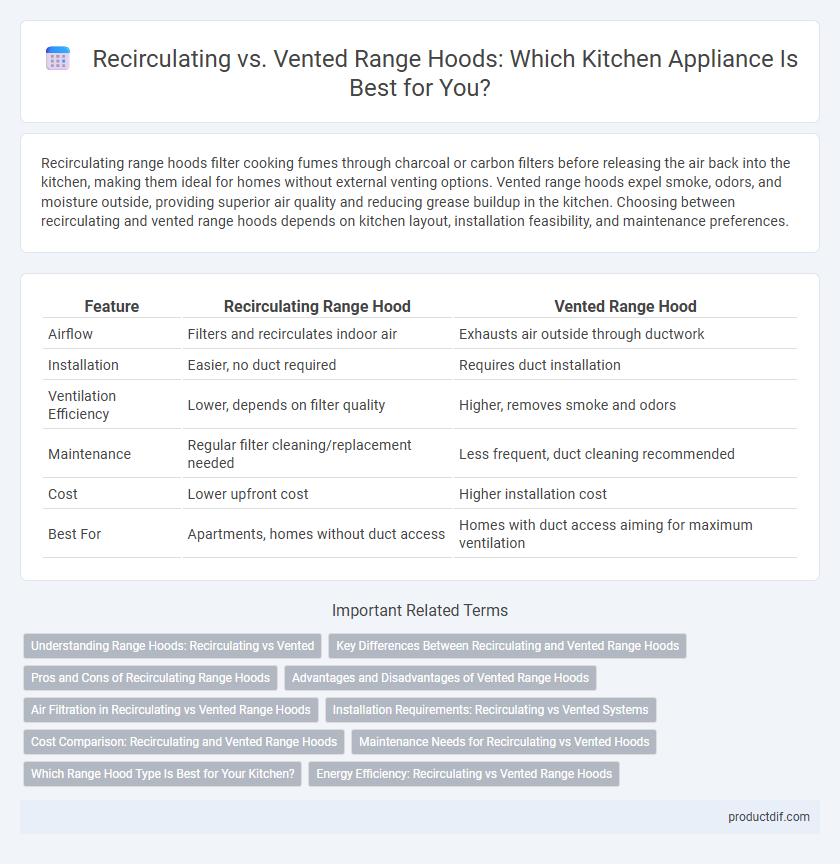Recirculating range hoods filter cooking fumes through charcoal or carbon filters before releasing the air back into the kitchen, making them ideal for homes without external venting options. Vented range hoods expel smoke, odors, and moisture outside, providing superior air quality and reducing grease buildup in the kitchen. Choosing between recirculating and vented range hoods depends on kitchen layout, installation feasibility, and maintenance preferences.
Table of Comparison
| Feature | Recirculating Range Hood | Vented Range Hood |
|---|---|---|
| Airflow | Filters and recirculates indoor air | Exhausts air outside through ductwork |
| Installation | Easier, no duct required | Requires duct installation |
| Ventilation Efficiency | Lower, depends on filter quality | Higher, removes smoke and odors |
| Maintenance | Regular filter cleaning/replacement needed | Less frequent, duct cleaning recommended |
| Cost | Lower upfront cost | Higher installation cost |
| Best For | Apartments, homes without duct access | Homes with duct access aiming for maximum ventilation |
Understanding Range Hoods: Recirculating vs Vented
Recirculating range hoods filter air through charcoal or carbon filters to remove odors and then release the cleaned air back into the kitchen, making them ideal for homes without ductwork. Vented range hoods expel smoke, grease, and airborne particles outside the home via ductwork, providing superior air quality and moisture control. Choosing between recirculating and vented models depends on kitchen layout, ventilation needs, and installation feasibility.
Key Differences Between Recirculating and Vented Range Hoods
Recirculating range hoods filter cooking fumes and odors through charcoal or carbon filters before releasing clean air back into the kitchen, making them ideal for spaces without external venting options. Vented range hoods, also known as ducted hoods, expel smoke, heat, and odors directly outside through ductwork, providing more effective ventilation and improved air quality. Key differences include installation complexity--vented hoods require external ducts while recirculating models do not--and maintenance, as recirculating hoods need regular filter replacements, whereas vented hoods primarily require duct cleaning.
Pros and Cons of Recirculating Range Hoods
Recirculating range hoods offer the advantage of easy installation since they do not require ductwork and can be placed anywhere in the kitchen, making them ideal for apartments and homes without external vents. They filter and clean air through charcoal or carbon filters, effectively reducing odors but less efficiently removing moisture and smoke compared to vented models. However, their filters require regular replacement to maintain performance, and they may not provide the same level of ventilation, possibly leading to lingering grease and humidity over time.
Advantages and Disadvantages of Vented Range Hoods
Vented range hoods effectively remove smoke, odors, and airborne grease by expelling them outside, ensuring improved indoor air quality and preventing moisture buildup. However, they often require complex ductwork installation, which can increase costs and limit placement options in kitchens without exterior walls. Maintenance involves regular cleaning of ductwork to prevent grease accumulation, but they generally provide superior ventilation compared to recirculating models.
Air Filtration in Recirculating vs Vented Range Hoods
Recirculating range hoods use charcoal filters to trap smoke, grease, and odors, filtering air before releasing it back into the kitchen, making them suitable for homes without external venting options. Vented range hoods exhaust air directly outside through ductwork, effectively removing heat, moisture, and airborne contaminants for superior indoor air quality. The choice between these hoods impacts ventilation efficiency, with vented systems offering more thorough air filtration and odor control compared to recirculating models.
Installation Requirements: Recirculating vs Vented Systems
Recirculating range hoods require no external ductwork, making them ideal for kitchens without access to an outside vent, as they filter and recirculate air through charcoal filters. Vented range hoods necessitate proper duct installation to the exterior of the building, which involves cutting through walls or ceilings and complying with local building codes for airflow and exhaust. The complexity and cost of vented hoods installation are higher compared to recirculating systems, which are easier to install but less effective at removing smoke and odors.
Cost Comparison: Recirculating and Vented Range Hoods
Recirculating range hoods typically cost between $150 and $500, making them a budget-friendly option that requires no duct installation, which further reduces expenses. Vented range hoods generally range from $200 to $800 or more due to the need for ductwork, installation labor, and potential modifications to existing cabinetry or walls. Long-term energy costs for vented hoods may be higher but provide superior air quality by removing smoke and odors outside, whereas recirculating hoods rely on replaceable filters, adding to maintenance costs over time.
Maintenance Needs for Recirculating vs Vented Hoods
Recirculating range hoods require frequent filter cleaning or replacement, as they trap grease and odors internally without venting air outside. Vented hoods need less filter maintenance but demand regular duct inspections to prevent grease buildup and ensure efficient airflow. Proper upkeep of either type prolongs appliance lifespan and maintains kitchen air quality.
Which Range Hood Type Is Best for Your Kitchen?
Recirculating range hoods filter and recycle air, making them ideal for kitchens without external venting options, while vented range hoods expel smoke, odors, and moisture outside, providing superior air quality. Choosing the best range hood depends on kitchen layout and ventilation availability; vented models offer more effective contaminant removal, whereas recirculating units are easier to install and maintain. Proper size, CFM rating, and noise level are key factors in selecting a range hood that ensures optimal cooking environment and air purification.
Energy Efficiency: Recirculating vs Vented Range Hoods
Recirculating range hoods use charcoal filters to clean and recirculate air, which conserves energy by avoiding air exchange with the outdoors. Vented range hoods expel air outside, requiring more energy for heating or cooling to balance indoor temperatures. Choosing a recirculating model can reduce HVAC load, improving overall energy efficiency in homes with tight insulation.
Recirculating vs Vented Range Hood Infographic

 productdif.com
productdif.com